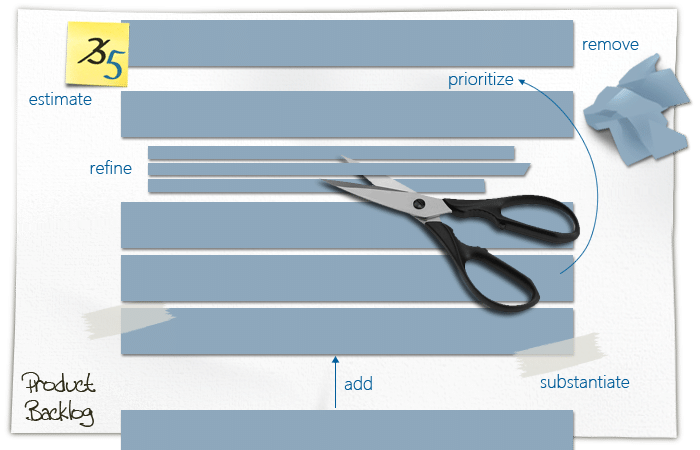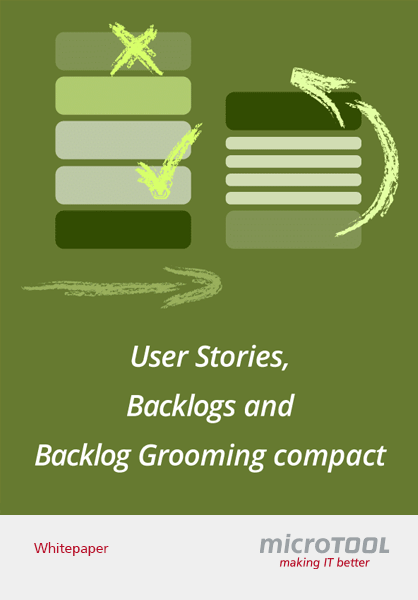Backlog Grooming or Refinement. Discuss and Prepare Backlog Items.
What is backlog grooming or refinement? What advantages does it offer and how is it done?

Backlog grooming is a meeting of the Scrum team in which the product backlog items like user stories, bugs, technical stories, etc are discussed and the next sprint planning is prepared.
For example, user stories are filled with more information, change their priorities and some are removed completely.
Or the team refines ("slices") epics into smaller user stories, estimates their workload and adds completely new backlog items.
What Is Backlog Grooming or Refinement?
Like a garden, the product backlog of your Scrum project also has to be trimmed and maintained. Which product items (user stories, bugs, technical stories, etc) will you implement in your next sprint? Are they formulated clearly enough and does you scope allow them to be implemented in one sprint? To clarify these questions, the development team and the product owner meet for some backlog grooming (or backlog refinement, backlog estimation or story time). Here, you take the items more precisely under the magnifying glass, add details, clear up unclearness, estimate workloads, change priorities, add new items, or remove entire items. Backlog grooming is not an officially defined Scrum meeting, like, for example, the daily Scrum or sprint planning. However the Scrum guide advises carrying out backlog grooming or refinement regularly.
What Does the Scrum Guide Say about This?
“Product Backlog refinement is the act of breaking down and further defining Product Backlog items into smaller more precise items. This is an ongoing activity to add details, such as a description, order, and size. Attributes often vary with the domain of work. The Developers who will be doing the work are responsible for the sizing. The Product Owner may influence the Developers by helping them understand and select trade-offs.” [1]
Definition of backlog grooming or refinement:
Backlog grooming or refinement is a meeting in Scrum to discuss product backlog items and prepare the next sprint planning.
How to Carry Out Backlog Grooming / Refinement
The Scrum guide provides guidelines. How can these be implemented in practice?
“Product Backlog refinement is the act of breaking down and further defining Product Backlog items into smaller more precise items.”
In backlog grooming or refinement, the Scrum team considers individual items, for example, user stories that it wants to implement in the next sprint, and specifies the contents. For example, the team discusses the acceptance criteria or which components the user should have access to and what happens if the user makes invalid entries. The Scrum team refines large requirements like epics into small user stories so as to be able to implement them in a sprint. That way user stories will not only be revised in backlog grooming, new ones will also emerge. Many will be completely removed from the product backlog if the workload and benefit no longer match.
At the end of the refinement, the product backlog items should fulfil a Definition of Ready. Meaning they are ready for implementation in the next Sprint. To check if Product Backlog Items are ready, you can check them for so called INVEST criteria. These are:
I (Independent). The Product Backlog Items should be realizable independently of each other.
N (Negotiable). They should be negotiable as far as their implementation is concerned.
V (Valuable). They should be valuable to the stakeholders.
E (Estimable). They should be estimable in relation to other Product Backlog items.
S (Small). They should be small enough to be implemented within a timebox (e.g. within a Sprint).
T (Testable). They should be testable. Acceptance criteria such as the Definition of Done must be defined.
“This is an ongoing activity to add details, such as a description, order, and size. Attributes often vary with the domain of work.”
Backlog grooming is carried out regularly. Many organizations set the meeting three days before the end of a sprint. This way, the product owner has enough time to pursue the problems identified there before the next sprint. Others prefer having the meeting after half the sprint, or once a week. Those involved in the backlog grooming or refinement are the product owner, who leads the meeting, and the development team. If it is required for the situation, then the stakeholders can also be invited.
“The Developers who will be doing the work are responsible for the sizing. The Product Owner may influence the Developers by helping them understand and select trade-offs.”
During backlog grooming or refinement, product backlog items should be estimated. This task is the responsibility of the Development Team. Different methods can be used for this, such as Story Points. The developers are also responsible for correctly estimating the granularity of the product backlog items, i.e., for determining whether user stories can be implemented at all in a sprint. The Product Owner is in demand for prioritization, since he is responsible for the maximizing the value of a product. Techniques for prioritization are e.g. MoSCoW, Rocks, Pebbles and Sand, Plus – Zero – Minus or the Kano model.
The Scrum Guide prior to the new edition of 2020 recommended that Backlog Refinement should not take more than 10% of the capacity of the Development Team. This note is missing in the current version. Perhaps because the effort required for refinement can vary greatly from Sprint to Sprint. The advice was originally given to keep the Development Team working. However, many Scrum teams continue to follow it. Unlike the Daily Scrum, the Sprint Review and the Sprint Retrospective, the Backlog Refinement is not a defined event with a fixed timebox in the Scrum Guide.
Ideal Course of Backlog Grooming
- Scrum team identifies which product backlog items have to be specified.
- Product owner explains what it is and why it is needed.
- Development team understands the what and why.
- Development team know how they have to implement the item.
- Development team estimates the workload.
- Updated product backlog item continues to be worthwhile in terms of workload and benefit.
Alternative Course of Backlog Grooming
- Scrum team identifies which product backlog item has to be specified.
- Product owner explains what it is and why it is needed.
- Development team does not understand the what and why > they put the product backlog item back.
- Development team does not know how the item has to be implemented > more discussion, or the creation of a spike story is required.
- Development team estimates the workload.
- Updated product backlog item is no longer valuable in terms of workload and benefit > take the item out of the product backlog.
Advantages of Backlog Grooming / Refinement, Summarized
The product owner gets extra help to manage the product backlog
Information is given to all project participants
Backlog only contains truly relevant items
Questions and uncertainties can be quickly clarified (the "what" is explained)
Sprint planning can be prepared (the "how" can be clarified)
Risks are reduced because the backlog is discussed before sprints
Take care of your product backlog
Agile or hybrid projects with backlogs need transparency for all participants. You have to create requirements, user stories, bugs, technical stories or spike stories, manage them in the product backlog and plan releases as well as sprints. In large projects the overview can be lost quickly if you have to manage more than a hundred such items. And many project participants can be indecisive about the priorities or the workloads. Use software with which you can create your backlogs, set priorities and estimate workloads. If you perform backlog grooming, let the entries be visualized simply, for everyone, and clarify questions or uncertainties. Even changes can be directly maintained in a few clicks. That way the work of the product owner is simplified as well as the work of the development team. And the stakeholders will be glad about this.

